Games for science
Review of popular science games.
My parents and brother have recently been playing with enthusiasm the famous “2048” toy on their phones, training logic and mathematical skills. It's good. But it is even better when games contribute not only to individual development, but also to the progress of the whole world. Loudly said, of course, however, there are a number of games that are aimed at combining the pleasant and the useful for you with the useful for all. I am with the aim of promoting good things among people, presenting further a review of several such games.
Great screenshots are available.
EteRNA
http://eterna.cmu.edu/web
')
Eterna is a biological puzzle in which you have to design RNA molecules. Toy in the form of a flash program. It works quite quickly, even on an old computer. But for large molecules it slows down a bit. In it pleases beautiful design and simple rules. Let me remind you that RNA is ribonucleic acid, which performs the most diverse roles in living organisms. Many viruses (flu, for example) even have no DNA - RNA performs all the necessary functions. There is even a hypothesis of the world-RNA , which claims that life began with it.
RNA consists of a chain of nucleotides. Each nucleotide is a ribose + one of four variants of the base: adenine, guanine, cytosine, uracil. In the game you need to choose the correct order of bases, so that the chain takes the proper form, i.e. coagulated into the correct secondary structure. How exactly these bases interact is told in the training levels. There are tasks of different types: in some you can choose all the bases on your own, in others some of the bases are set initially, also in the puzzles there are restrictions on the types of the base, or vice versa, the number and type of bases to be used are indicated. In the most difficult puzzles, several final forms are given at once, into which the molecule should fold, depending on the conditions. So said in the wiki, I have not seen such. There are 2 types of tasks. Challenges - invented by the creators of the puzzle game. About each problem is attached a very brief scientific background. For me as a whole, it is not clear, but informative. Player Puzzles - created by the players themselves. Some of the proposed puzzles can then be synthesized in vitro, if they prove to be interesting for science. For 2011, 306 different molecules were synthesized. I was not able to find information on the synthesized molecules on the site, although it seems to be there. In the player profile, in any case, there is a tab "synthesized molecules."
The goal of the game, as I understand it, is to improve the predictive power of the RNA folding algorithms, which, generally speaking, twist much more diversely than proteins, and therefore it is harder to predict their configuration. The current computational methods of silicon computers often beat the target. The FAQ says that even the best folding programs are not as smart as those people who have been playing for a couple of weeks or months. The molecules that computers count do not add up as they should in life, and that’s why you have to useself-learning neural networks of people. Still, biocomputers have great prospects!
There is also NovaLabs (you need to register in a new way) there you can watch short explanatory videos and go through educational puzzles where you need to collect, for example, transport RNA. For schoolchildren it would be very interesting. In my opinion, not enough serious explanations. For example, why is the assembled molecule a transport RNA, and not some other one? Why is RNA of this particular form capable of self-copying? And if a little change it, it will no longer be self-replicating? All this is very mysterious. The game creates a feeling of simplicity of biotechnology, but its principles remain unknown to the player.

In the screenshot, one of the molecules in the assembly process.

Another screen, because I really like the way this game looks.
Nanocrafter
http://nanocrafter.org
This is a game about DNA. As a result, they propose to collect anything from logical computer elements to nanomechanisms. The game seems to have appeared recently (version of beta), so the community is not too big, and the interface is not all smooth. Design - so-so. There are few tasks. The problems in the tutorial seemed more complicated than in EteRNA. However, I should not be guided, my love for logic is not mutual. I did not solve some tasks, some were solved by my favorite method of random sorting.
In tasks, it is required to select such a configuration so that a piece of DNA with an asterisk is freed, and the “broken” pieces are connected to another element. The scientific side is not entirely clear. For example, what exactly are the fragments that a player manipulates? Chunks of DNA, but which ones? Why are they of different colors? What are “broken” elements and elements with an asterisk? There are contests, for example, to assemble a NAND valve.
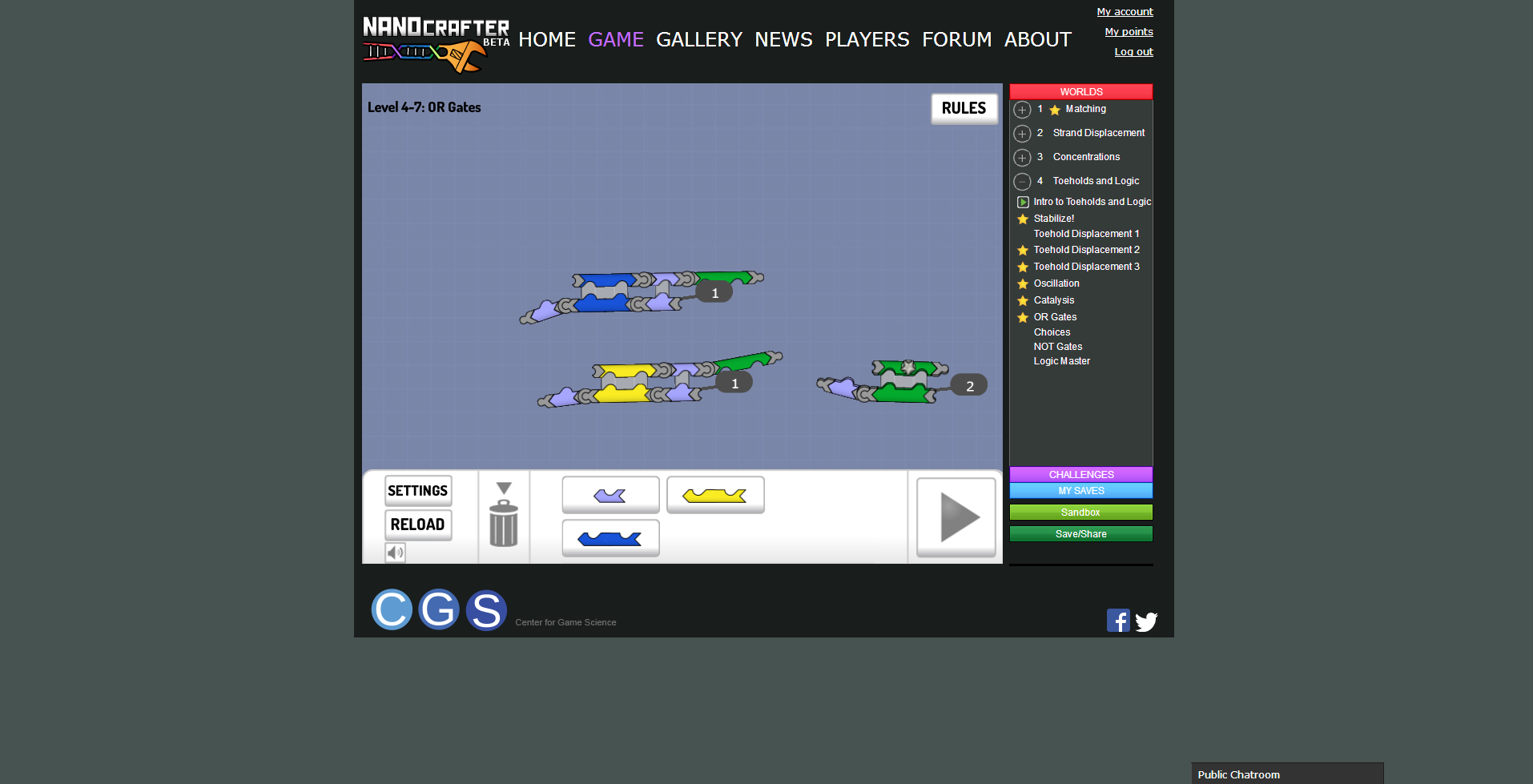
The screenshot shows the logic gate Or from the tutorial. Why it is he, and how it works in DNA, I still do not understand too much. The explanations are very bad or not at all. It's a pity. But perhaps this is because I am not a programmer and I do not understand the work of the computational logic well.
I like the game, however. I really want it to develop. If a large community meets, and indeed it will be possible to make complex nanomachines and computers will be great. For this, of course, they need to improve the interface.
FoldIt
http://fold.it/portal
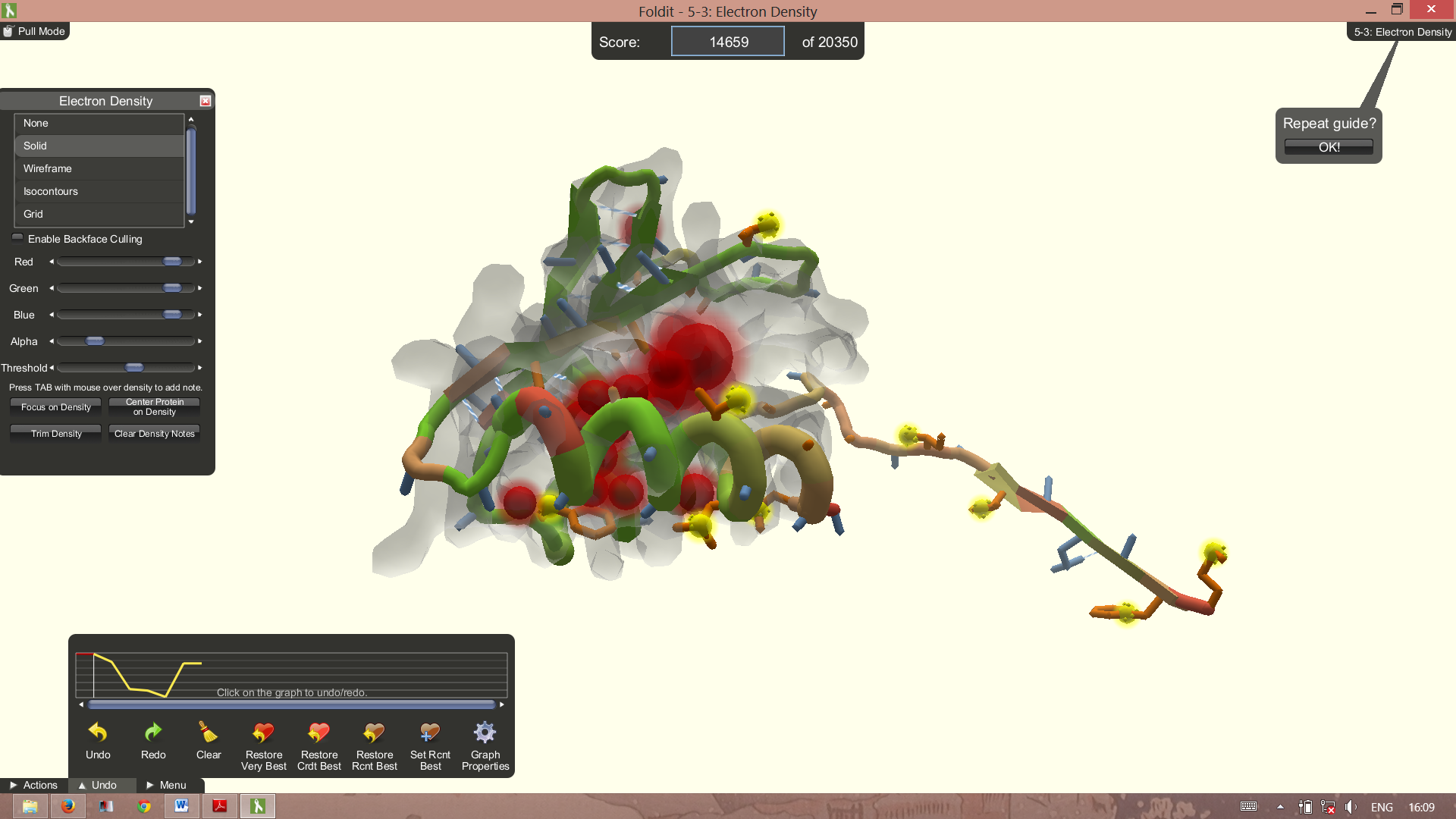
RNA, DNA, now it is time for proteins. In this famous game, the task is the opposite of that given in EteRNA. In the latter, it is necessary to choose a chemical sequence that will take a given shape, and here, on the contrary, for a given sequence, guess what kind of tertiary structure it will have in reality. The game is played in 3D, and not on the plane, which greatly complicates everything. But there are a lot of tools, various tasks. The scientific side of the process is also quite well covered. There is a lot of information in their wiki, there are forums. There are a lot of participants too. Players know two major scientific achievements. The first is the deciphering of the crystal structure of the M-PMV virus, which causes AIDS in monkeys. Scientists could not get this result for 10 years. The second is an improvement in the design of some enzyme.
I will not talk about this game a lot, it is known. I advise everyone to play it. To do this, you need to download the client to your computer.
About the game in the wiki: http://en.wikipedia.org/wiki/Foldit
Eyewire
http://eyewire.org
Here you need to build a three-dimensional structure of the neuron in its slice. Playing online and as I understand it, requires WebGL. The neuron is located inside the cube, which in reality has sides of 4.5 microns. You are given an initial slice and a slice map, and then you need to build a neuron path from one wall to another along this map. In general, something like a maze. In my opinion, quite interesting. I can not say that this is a logical game. It's all about spatial imagination and pattern recognition, as well as intuition. Players compete for the number of cubes passed and for points that are awarded in the process.
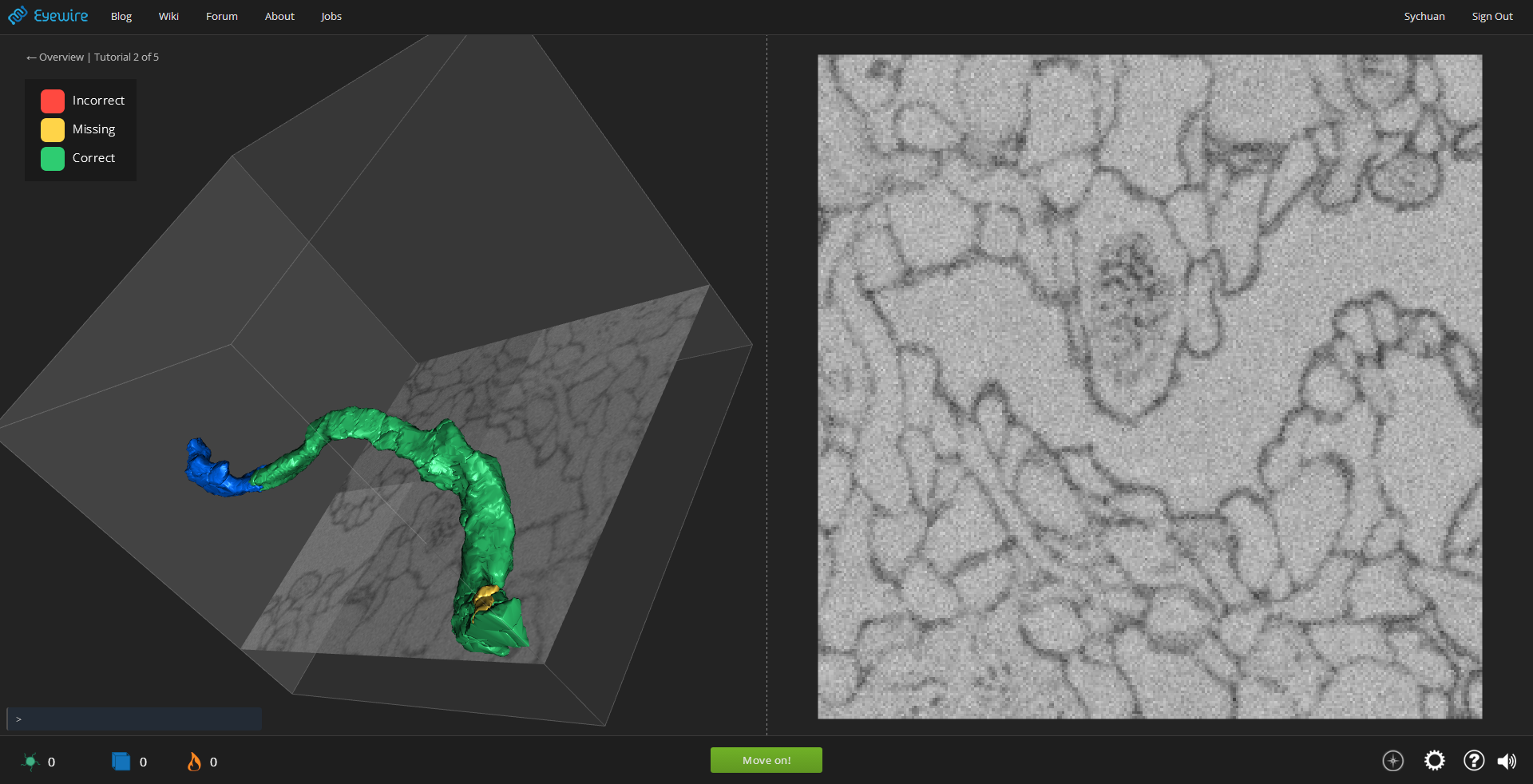
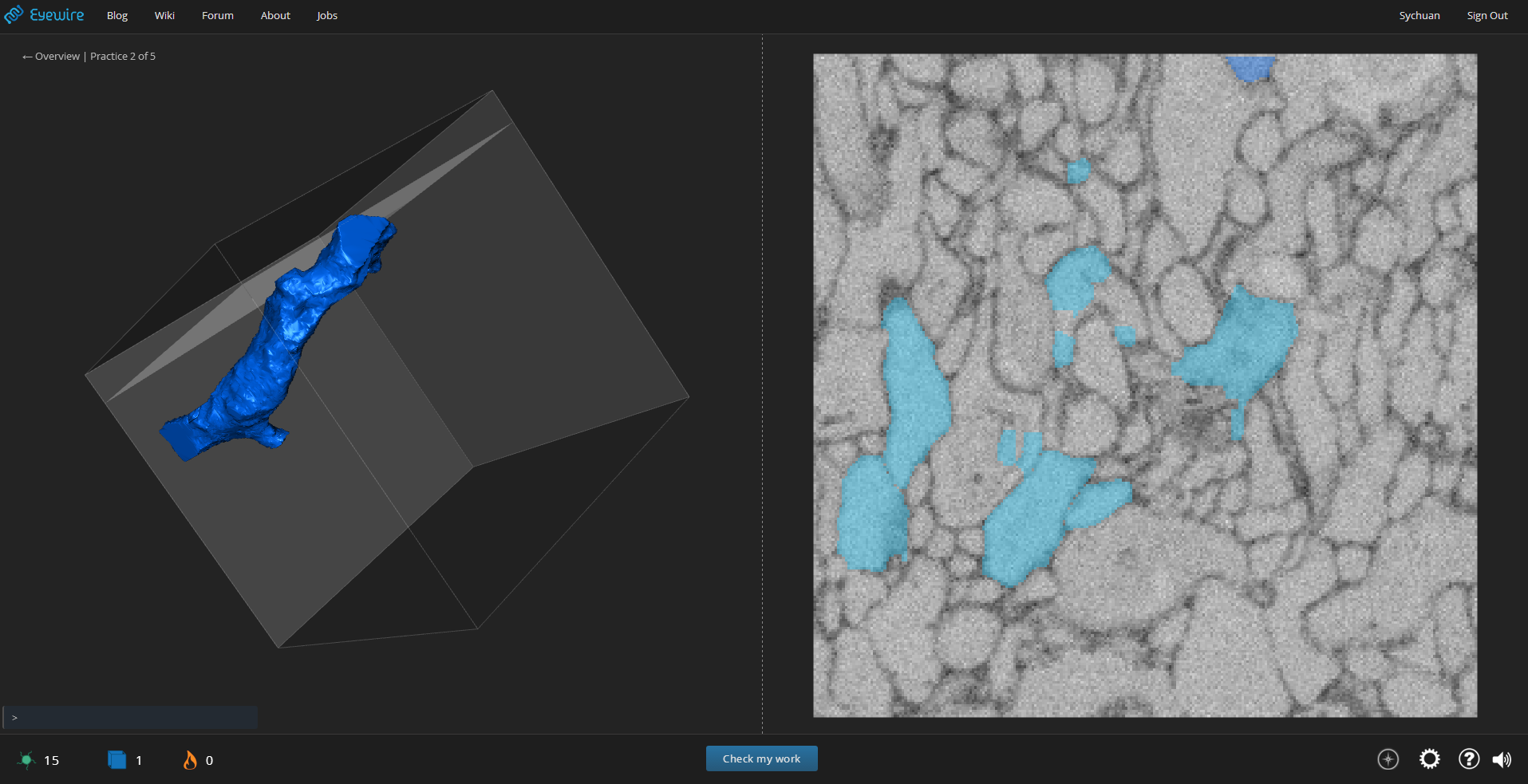
Phylo
http://phylo.cs.mcgill.ca/
Beautiful design and nice music. Also available in online version only. As I understand it, the game on HTML that I like. The task is to arrange the colored bricks so that the columns match well with each other. You also need to get rid of gaps in the sequences. The ideal is not always possible, so you need to choose the optimal configuration. In general, I recommend reading the tutorial before playing, there is a lot explained. I found the game pretty boring. The main strategy that I followed was to shift all sequences to the right until it stops.
The authors insist that in this way you will help to fight against various diseases, but unlike EteRNA and FoldIt, the immediate meaning of the actions is not too obvious to the player. In theory, you align the genetic sequences of ancestors and descendants to find connections in them, highlight mutations, and so on. This is called multiple sequence alignment. This is done then, so that later our creative methods can be explored and (as you thought) teach them to our silicon friends, who make everything much more agile and respectful.
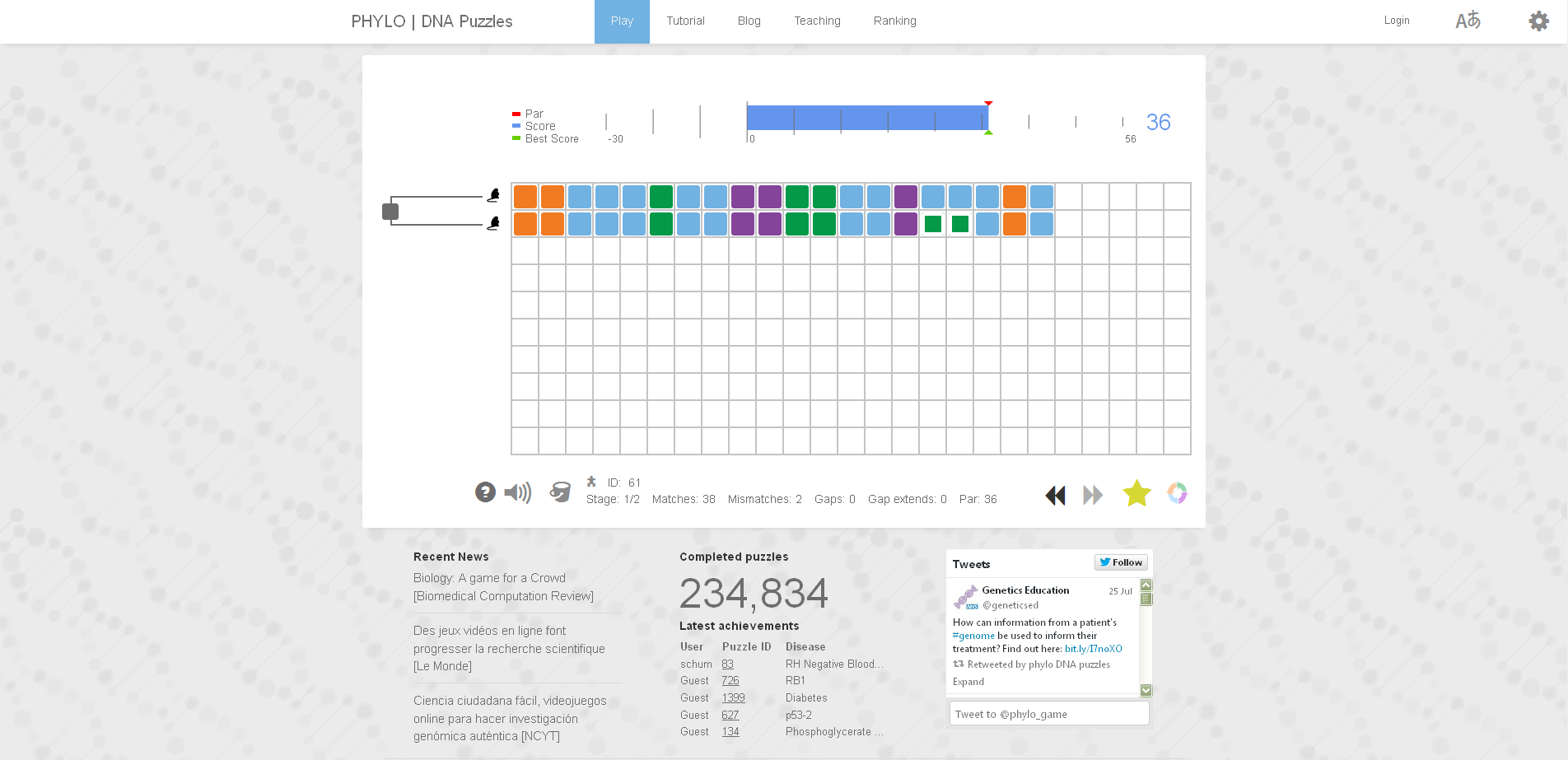
More games
Flow jam
http://flowjam.verigames.com
Very little information, but is the game in some mysterious way related to the search for bugs? or to verify the software.
Here is a little more. In my opinion, they are only at the very beginning of the journey, but already interesting.
Play to Cure: Genes in Space
http://www.cancerresearchuk.org/support-us/play-to-cure-genes-in-space
Game on the phone. You fly through space and collect the mysterious substance. Sometimes come across asteroids. On earned points you can upgrade your spacecraft. All this helps fight cancer.
My parents and brother have recently been playing with enthusiasm the famous “2048” toy on their phones, training logic and mathematical skills. It's good. But it is even better when games contribute not only to individual development, but also to the progress of the whole world. Loudly said, of course, however, there are a number of games that are aimed at combining the pleasant and the useful for you with the useful for all. I am with the aim of promoting good things among people, presenting further a review of several such games.
Great screenshots are available.
EteRNA
http://eterna.cmu.edu/web
')
Eterna is a biological puzzle in which you have to design RNA molecules. Toy in the form of a flash program. It works quite quickly, even on an old computer. But for large molecules it slows down a bit. In it pleases beautiful design and simple rules. Let me remind you that RNA is ribonucleic acid, which performs the most diverse roles in living organisms. Many viruses (flu, for example) even have no DNA - RNA performs all the necessary functions. There is even a hypothesis of the world-RNA , which claims that life began with it.
RNA consists of a chain of nucleotides. Each nucleotide is a ribose + one of four variants of the base: adenine, guanine, cytosine, uracil. In the game you need to choose the correct order of bases, so that the chain takes the proper form, i.e. coagulated into the correct secondary structure. How exactly these bases interact is told in the training levels. There are tasks of different types: in some you can choose all the bases on your own, in others some of the bases are set initially, also in the puzzles there are restrictions on the types of the base, or vice versa, the number and type of bases to be used are indicated. In the most difficult puzzles, several final forms are given at once, into which the molecule should fold, depending on the conditions. So said in the wiki, I have not seen such. There are 2 types of tasks. Challenges - invented by the creators of the puzzle game. About each problem is attached a very brief scientific background. For me as a whole, it is not clear, but informative. Player Puzzles - created by the players themselves. Some of the proposed puzzles can then be synthesized in vitro, if they prove to be interesting for science. For 2011, 306 different molecules were synthesized. I was not able to find information on the synthesized molecules on the site, although it seems to be there. In the player profile, in any case, there is a tab "synthesized molecules."
The goal of the game, as I understand it, is to improve the predictive power of the RNA folding algorithms, which, generally speaking, twist much more diversely than proteins, and therefore it is harder to predict their configuration. The current computational methods of silicon computers often beat the target. The FAQ says that even the best folding programs are not as smart as those people who have been playing for a couple of weeks or months. The molecules that computers count do not add up as they should in life, and that’s why you have to use
There is also NovaLabs (you need to register in a new way) there you can watch short explanatory videos and go through educational puzzles where you need to collect, for example, transport RNA. For schoolchildren it would be very interesting. In my opinion, not enough serious explanations. For example, why is the assembled molecule a transport RNA, and not some other one? Why is RNA of this particular form capable of self-copying? And if a little change it, it will no longer be self-replicating? All this is very mysterious. The game creates a feeling of simplicity of biotechnology, but its principles remain unknown to the player.

In the screenshot, one of the molecules in the assembly process.
Another screen, because I really like the way this game looks.
Nanocrafter
http://nanocrafter.org
This is a game about DNA. As a result, they propose to collect anything from logical computer elements to nanomechanisms. The game seems to have appeared recently (version of beta), so the community is not too big, and the interface is not all smooth. Design - so-so. There are few tasks. The problems in the tutorial seemed more complicated than in EteRNA. However, I should not be guided, my love for logic is not mutual. I did not solve some tasks, some were solved by my favorite method of random sorting.
In tasks, it is required to select such a configuration so that a piece of DNA with an asterisk is freed, and the “broken” pieces are connected to another element. The scientific side is not entirely clear. For example, what exactly are the fragments that a player manipulates? Chunks of DNA, but which ones? Why are they of different colors? What are “broken” elements and elements with an asterisk? There are contests, for example, to assemble a NAND valve.

The screenshot shows the logic gate Or from the tutorial. Why it is he, and how it works in DNA, I still do not understand too much. The explanations are very bad or not at all. It's a pity. But perhaps this is because I am not a programmer and I do not understand the work of the computational logic well.
I like the game, however. I really want it to develop. If a large community meets, and indeed it will be possible to make complex nanomachines and computers will be great. For this, of course, they need to improve the interface.
FoldIt
http://fold.it/portal

RNA, DNA, now it is time for proteins. In this famous game, the task is the opposite of that given in EteRNA. In the latter, it is necessary to choose a chemical sequence that will take a given shape, and here, on the contrary, for a given sequence, guess what kind of tertiary structure it will have in reality. The game is played in 3D, and not on the plane, which greatly complicates everything. But there are a lot of tools, various tasks. The scientific side of the process is also quite well covered. There is a lot of information in their wiki, there are forums. There are a lot of participants too. Players know two major scientific achievements. The first is the deciphering of the crystal structure of the M-PMV virus, which causes AIDS in monkeys. Scientists could not get this result for 10 years. The second is an improvement in the design of some enzyme.
I will not talk about this game a lot, it is known. I advise everyone to play it. To do this, you need to download the client to your computer.
About the game in the wiki: http://en.wikipedia.org/wiki/Foldit
Eyewire
http://eyewire.org
Here you need to build a three-dimensional structure of the neuron in its slice. Playing online and as I understand it, requires WebGL. The neuron is located inside the cube, which in reality has sides of 4.5 microns. You are given an initial slice and a slice map, and then you need to build a neuron path from one wall to another along this map. In general, something like a maze. In my opinion, quite interesting. I can not say that this is a logical game. It's all about spatial imagination and pattern recognition, as well as intuition. Players compete for the number of cubes passed and for points that are awarded in the process.


Phylo
http://phylo.cs.mcgill.ca/
Beautiful design and nice music. Also available in online version only. As I understand it, the game on HTML that I like. The task is to arrange the colored bricks so that the columns match well with each other. You also need to get rid of gaps in the sequences. The ideal is not always possible, so you need to choose the optimal configuration. In general, I recommend reading the tutorial before playing, there is a lot explained. I found the game pretty boring. The main strategy that I followed was to shift all sequences to the right until it stops.
The authors insist that in this way you will help to fight against various diseases, but unlike EteRNA and FoldIt, the immediate meaning of the actions is not too obvious to the player. In theory, you align the genetic sequences of ancestors and descendants to find connections in them, highlight mutations, and so on. This is called multiple sequence alignment. This is done then, so that later our creative methods can be explored and (as you thought) teach them to our silicon friends, who make everything much more agile and respectful.
More games
Flow jam
http://flowjam.verigames.com
Very little information, but is the game in some mysterious way related to the search for bugs? or to verify the software.
Here is a little more. In my opinion, they are only at the very beginning of the journey, but already interesting.
Play to Cure: Genes in Space
http://www.cancerresearchuk.org/support-us/play-to-cure-genes-in-space
Game on the phone. You fly through space and collect the mysterious substance. Sometimes come across asteroids. On earned points you can upgrade your spacecraft. All this helps fight cancer.
Source: https://habr.com/ru/post/231925/
All Articles